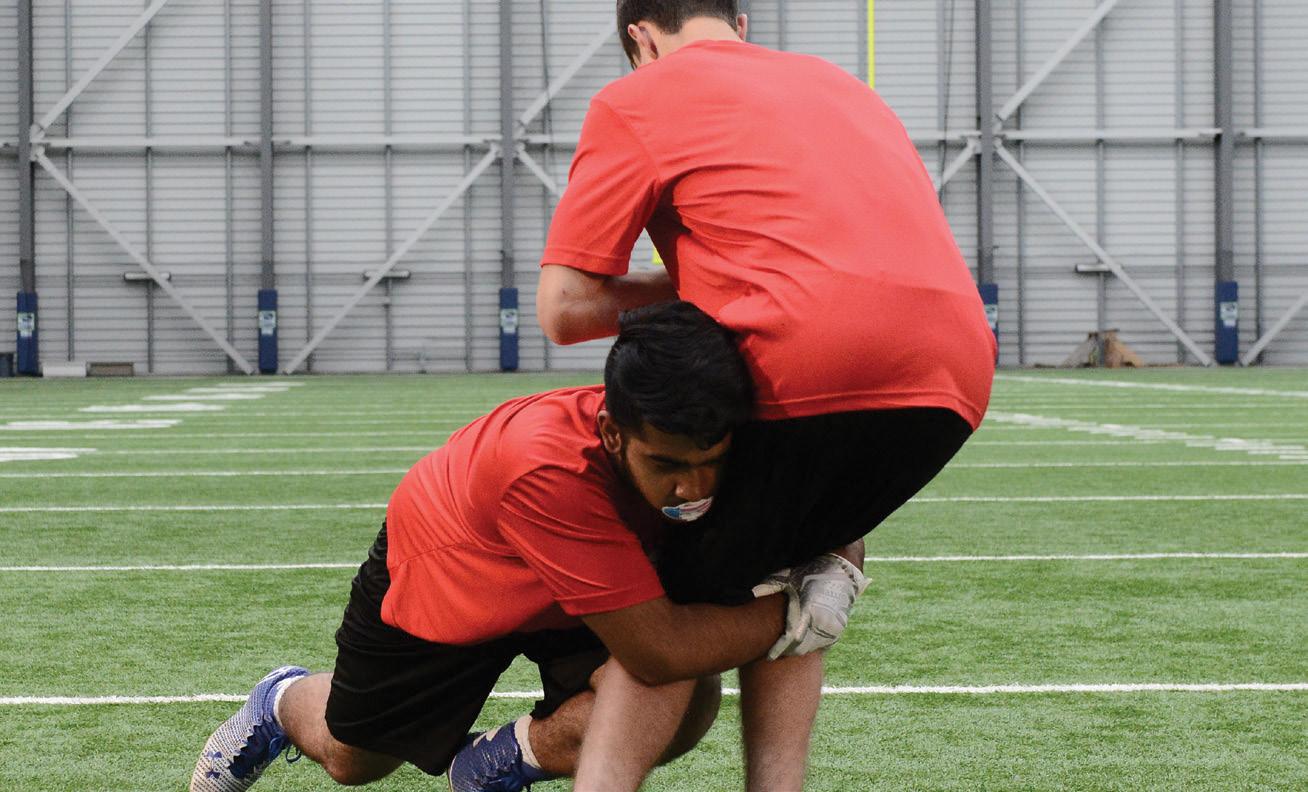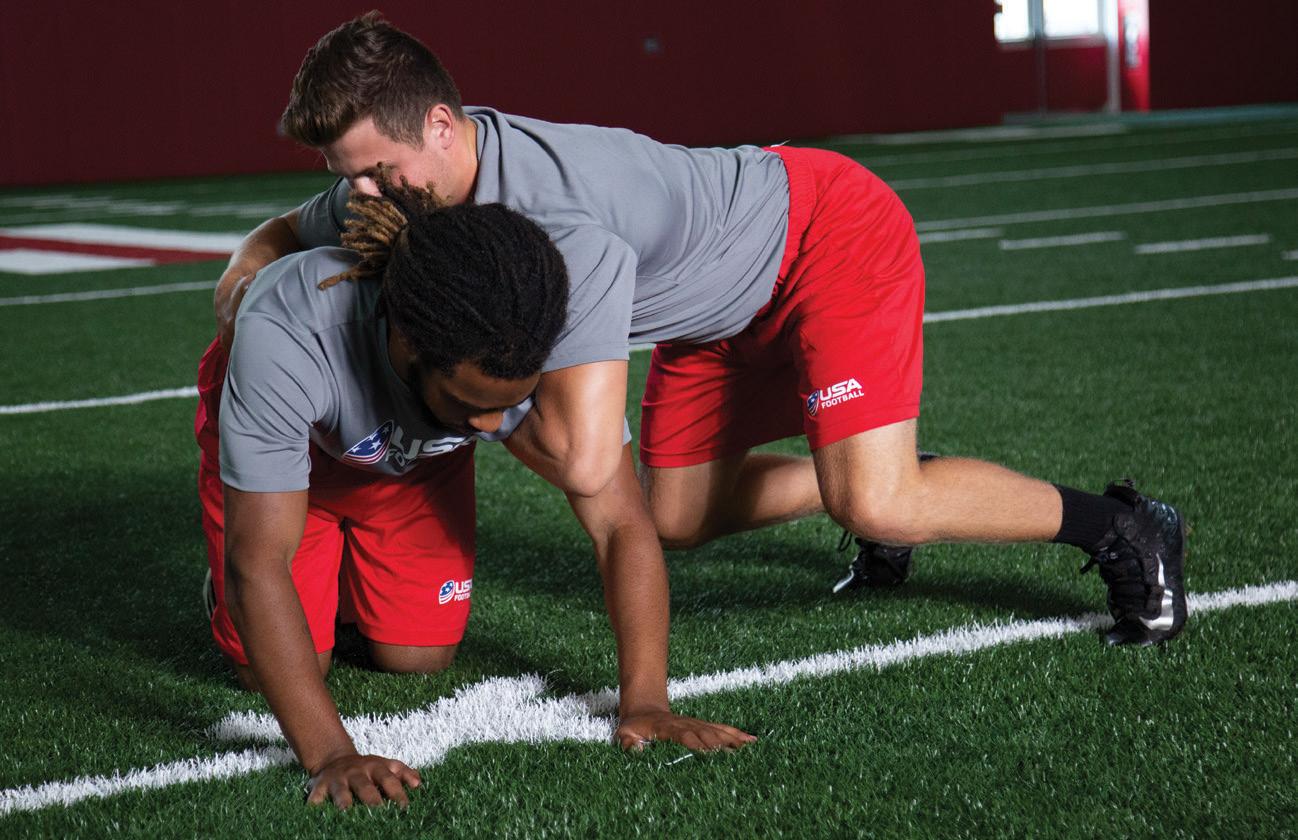
9 minute read
Three-Ball Drills for Receivers
THREE-BALL DRILLS FOR WIDE RECEIVERS
BY KUTZTOWN UNIVERSITY WIDE RECEIVERS COACHES MATTHEW PIROLLI & STEVE HECK
Notre Dame

Villanova

Mini Villanova Three-ball drills we have done almost every day were: Notre Dame, Mini Villanova and Villanova. We break our ball drills down into how many catches the wide receiver is getting in that given drill. You can find other ways to break them down; this was just easiest for us.
The Notre Dame drill is one we use to focus on our wide receivers footwork and knee drive in and out of cuts. The take-off cone should be about 5 to 7 yards away from the cones the wide receiver is attacking. Having one cone at the start, the other three should be arranged with two in line of the starting cone but about a yard or so apart. You can make the distance between these cones larger or smaller depending on how well your receivers perform the more you do the drill. The last cone should be off to the side of the furthest cone.
The wide receiver will get a good take off attacking the cone furthest from him. Once they reach that they should breakdown and very tightly work around the cone going inside toward the cone behind them, as they work around that cone should then break off to the one off to the side then break back towards the sideline or where they began. Based on where the coach stands this can either be a sideline toe-touch catch or an over the shoulder fade ball scenario.
The Notre Dame drill is one that only involves one ball so in our experience this is one you let the group leader take control of during individual periods. Maybe as the coach you run this one in the offseason during free time after workouts so players get familiar but after that players should be able to control this one on their own. I have found that the older guys teach the young guys and no one slacks off because they all want to get something out of the drill. It doesn’t take a ton of space to set up and is a quick-hitter.
For the ball circuit, it is important to have drills that offer various challenges to players in terms of top end footwork, hand and eye preparation and ball skills. Also, try to find drills that are relatively easy to set up. The VILLANOVA drill is a 10-yard box that requires three footballs and three cones/chutes. A coach should manage any ball drills that require three or more balls. The receiver takes off from the sideline running toward cone/chute one where he breaks down and makes a 45-degree curl break and catches ball one. It’s very important to emphasize tucking the balls away in multi-catch drills. After the catch, the receiver flips the ball out of the drill and makes another 45-degree cut. There is no ball at cone/chute two.
As the receiver heads to cone/chute three he will make a 90-degree dig or out type break catching and tucking ball two. The final phase of VILLANOVA entails the receiver making a speed cut around cone/chute one to receive a boundary awareness catch for ball three. It is critical to make sure the sideline area is cleared of equipment and players. Coach the receiver to focus on the ball and FEEL the sideline. To save time have any players who are not running through the drill help track down the footballs.
Our final drill will be Mini Villanova, this is another quick hitter but has two catches instead of just one. Mini Villanova is an 8 x 10 yard rectangle that requires two footballs, a pop-up dummy, a cone and a hula hoop. The receiver takes off towards the pop up and runs back in a 45-degree curl catching ball one. After a catch and tuck that mandates the receiver seeing himself tuck the ball away, he heads toward the cone. Like the Villanova drill, there is no ball thrown at the second break point. Emphasize arm activity and knee expression on the exit of the break. As the receiver heads toward the hula hoop he’s coached to make a tight speed cut arc around the hoop.
Emphasize arm activity as the receiver makes the speed cut. Ball two will be an obstructed view, sideline catch, with the pop up serving a dual role in this drill set up. We want the receiver to lose the ball for an instant while he must also gauge his own proximity to the rapidly approaching sideline. This is a drill student interns or players could manage with some prior tips from the WR coach. Anytime we are introducing a new drill we will go through a dry run pre-practice shake down to make sure everybody sees the drill.
A New Way to Teach USA FOOTBALL’S ADVANCED TACKLING SYSTEM HELPS COACHES TEACH DEFENSE
BY USA FOOTBALL STAFF
It’s the fourth quarter, and your inside linebacker just took a poor angle on an outside zone play, failing to connect with the ball-carrier...First down.
On the very next play, your outside linebacker didn’t drive his feet after connecting with a receiver, who took it to the house...Game over.
While grading film after the game, both receive a negative score for a “missed tackle.” But do those two tick marks really help you identify what went wrong on those plays or provide a solution during next week’s practice plan?
It’s time for a new approach. USA Football’s Advanced Tackling System, developed in-conjunction with Richie Gray, an international and multi-sport tackling expert, offers coaches a progressive framework to improve their defense’s most critical skill.
Within this system, coaches learn easily identifiable and efficient metrics to classify successes and failures within each tackle. Using these indicators, coaches can turn to drills and troubleshooting progressions within the system to provide rich feedback and address specific concerns for each player.
“The Advanced Tackling System meets coaches where they are and helps them not only find deficiencies in tackling but ways to measure and help players dominate each tackle,” said Rob Currin, head coach at Alden (N.Y.) High School. “This system enhances any current tackle system and can be implemented immediately.”

■ USA Football’s Senior
Manager of Education and Training Andy Ryland serves as the on-screen talent for the Advanced Tackling System. Ryland is a former Penn State linebacker, college rugby All-American, member of the U.S. Men’s National Rugby Team and NCAA Division I college football coach.
■ The second leg drill within USA Football’s Advanced Tackling System teaches players
how to transition from single-leg control to full control in order to bring the ball-carrier to the ground. This system, coming to USA Football coaching system site FootballDevelopment.com in January, gives coaches key performance indicators that they can identify, train and correct to develop better fundamental tacklers on the football field.

The foundation for this system was developed by Richie Gray, the founder of GSI and the 5 Fight Tackle System as well as a former professional rugby player who has coached on the highest levels in both that sport and American football. Gray worked in 2016 alongside the Miami Dolphins coaching staff to improve that team’s tackling skills and continues to work with individual NFL coaches and players each offseason.
The system breaks down every tackle into five core concepts, each of which can be defined and charted by coaches in both practices and games. ■ Track: The ability to get from anywhere on the field to the ball-carrier with speed, taking into account scheme, leverage and blockers in order to make the tackle. ■ Prepare: The ability to transition from tracking to getting into the correct body position with proper foot placement for imminent contact and type of tackle being made. ■ Connect: Winning at the point of contact through technique, accuracy and the proper mentality. ■ Accelerate: The ability to generate force through the feet into the ground to provide sustained pressure and generate controlled power. ■ Finish: Taking the tackle to the ground with full control of the ball-carrier – all the way to the deck.
“You’ve got a player who misses tackles, you can track it back to one or two of our KPIs (key performance indicators),” Gray said. “The whole system can be very complex for the highest level, but it can easily be simplified down to whatever level you’re at.”
USA Football’s Senior Manager of Education and Training and shoulder tackling expert Andy Ryland serves as the on-screen instructor of the system.
“The shoulder tackle is still a part of our system. It’s a great start,” Ryland said. “Now, what we’re doing, is we’re taking a chronological look at the tackle. We look at the pieces that lead up to the finish of the tackle. Within each of those pieces, I have a number of KPIs I can start to look at.”
Learn more about USA Football’s Advanced Tackling System by visiting footballdevelopment.com.
Coaches can create a free membership and download any three of the videos to see for themselves what the pros are teaching.
TWO SYSTEMS TO HELP YOU WIN EVERY SNAP

Build the most critical defensive skill within your athletes

ADVANCED TACKLING SYSTEM
Created with international and multi-sport tackling expert Richie Gray, the Advanced Tackling System focuses on fitting every element of how your team tackles together.
From execution in-game to practice planning to film breakdown and drills, this system is a comprehensive and cohesive approach that will change the way your team approaches tackling.
SHOULDER TACKLING SYSTEM
Built in partnership with the Seattle Seahawks, explore a foundational approach to tackling to develop better defenders and build a more efficient and physical defense.
This free system is endorsed by the NFL and USA Rugby. It starts with instruction, drills and coaching points to help your players with regards to Fundamentals and Leverage.

WIN THROUGH BETTER EXECUTION. GET THERE WITH USA FOOTBALL.
Many of the best football coaches and players provide inspiration to the people around them on a daily basis. We often present quotes from former players/coaches on Twitter @FNFCoaches. The following quotes received the most buzz from our followers.
On every team, there is a core group that sets the tone Leadership for everyone else. If the tone is positive, you have half the battle won. If it is negative, you are beaten before you ever walk on the field.” –Chuck Noll
Flash doesn’t win games. Hype doesn’t win games. ExecutionGoing out and executing and doing your job on a consistent basis is what wins.” –Clay Helton AMBITIONIf you sit back and spend too much time feeling good about what you did in the past, you’re going to come up short your next turn.” –Bill Belichick
Whether it’s a drill or a game, the most important Focusthing is to do the best you can and to not clutter your mind with things you can’t control.” –Mike Leach
DISCIPLINE Discipline to me is sacrifice; it’s willingness to give up something you want to do, so you can better yourself.” –Bobby Bowden






